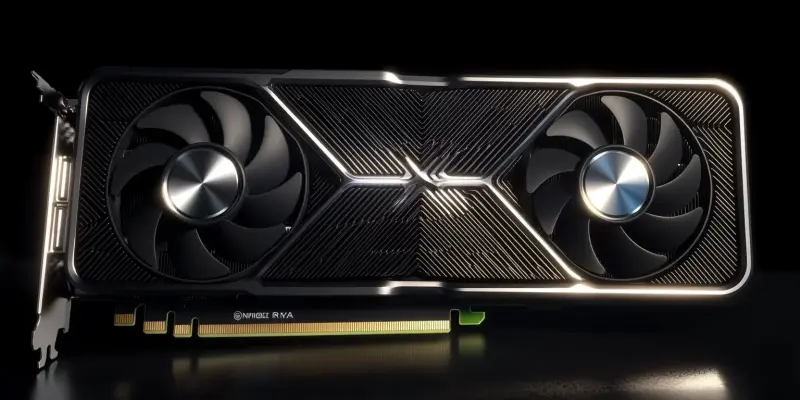In a highly anticipated move, NVIDIA has officially revealed its GeForce RTX 50 series, poised to redefine the boundaries of graphics performance and technological innovation. The lineup, headlined by the flagship RTX 5090, promises significant upgrades across the board, showcasing the latest advancements in the company’s Blackwell architecture. The release schedule for the new series has been strategically planned, with the review embargo for the RTX 5090 lifting on January 24, 2025. The subsequent models, including the RTX 5080 and the RTX 5090D, a variant uniquely tailored for the Chinese market, will have their embargoes lifted on January 30, 2025. This staggered approach aims to build sustained momentum and generate excitement as each model’s specifications and capabilities become publicly known.
The introduction of NVIDIA’s Blackwell architecture marks a significant leap forward in GPU technology. The RTX 5090 is set to feature an impressive 32 GB of GDDR7 memory with a 512-bit memory bus and a total bandwidth of 1792 GB/s. Additionally, users can expect a considerable increase in GPU cores and clock speeds. These enhancements position the RTX 5090 as not only a powerful tool for gaming but also as an asset for professionals involved in demanding tasks such as video editing, 3D rendering, and complex simulations. This prioritization of the high-end model in the release schedule highlights NVIDIA’s intent to establish a strong market perception and appeal to enthusiasts who rely on top-tier performance.
Review Embargo Schedule and Delays
While the flagship RTX 5090 takes center stage, the rest of the RTX 50 series follows with a methodically planned rollout. The RTX 5070 Ti, RTX 5070, RTX 5060 Ti, and RTX 5060 have launches set between February and April 2025. The deliberate gaps between these releases are likely designed to maintain a steady stream of attention and ensure that each model gets its deserved spotlight. This tiered release also helps NVIDIA manage supply chains and adapt to market demands more effectively, ensuring sufficient product availability and addressing any potential technical adjustments.
One point of interest in the rollout schedule is the delay concerning the RTX 5080’s review embargo. Initially planned for a simultaneous release with the RTX 5090, the RTX 5080’s BIOS was released late in December, leading NVIDIA’s partners to extend their support timelines. This delay underscores the commitment to product quality and ensuring that reviewers and end-users experience the GPU’s full potential right from the outset. Such transparency and adherence to quality standards underline NVIDIA’s strategies to maintain trust and reliability within its user base.
Advancements in Blackwell Architecture
The Blackwell architecture powering the RTX 50 series brings several advancements, with a strong emphasis on performance and efficiency. Preliminary specifications suggest notable increases in GPU cores, clock speeds, and memory speeds across the range. For example, the RTX 5090’s 32 GB of GDDR7 memory coupled with a 512-bit memory bus heralds a dramatic boost in overall bandwidth. This translates to more fluid and intricate gaming experiences, as well as enhanced performance for graphics-intensive applications. Another significant benefit is the expected improvement in power efficiency, marking a vital step forward in reducing the overall energy consumption of high-performance GPUs.
NVIDIA’s strategic focus is to not only meet but exceed the growing demands of the competitive GPU market. By catering to a wide range of consumers—from hardcore gamers to professional content creators—the RTX 50 series aims to establish a comprehensive suite capable of addressing diverse performance needs and budgets. Although certain specifications, such as the exact L2 cache sizes and total board power (TBP) for some models, remain under wraps, NVIDIA hinted at considerable technological leaps that will set new industry standards. These enhancements are expected to differentiate the RTX 50 series significantly from its predecessors, maintaining NVIDIA’s position at the forefront of GPU innovation.
Final Thoughts and Market Impact
NVIDIA has officially unveiled its GeForce RTX 50 series, set to push the limits of graphics performance and innovation. Leading the lineup is the RTX 5090, boasting notable upgrades and the latest advancements from the company’s Blackwell architecture. The series release is highly strategic, with the review embargo for the RTX 5090 lifting on January 24, 2025. Other models, including the RTX 5080 and the RTX 5090D—specially designed for the Chinese market—will have their review embargoes lifted on January 30, 2025. This staggered release builds ongoing excitement as each model’s specs and capabilities are revealed.
NVIDIA’s Blackwell architecture represents a major leap in GPU technology. The RTX 5090 features a staggering 32 GB of GDDR7 memory with a 512-bit memory bus and a total bandwidth of 1792 GB/s. Users will also see a significant increase in GPU cores and clock speeds. These upgrades make the RTX 5090 not only a powerful gaming tool but also invaluable for professionals in video editing, 3D rendering, and complex simulations. This focus on the high-end model underscores NVIDIA’s intent to cement a strong market position and attract enthusiasts who seek top-tier performance.

